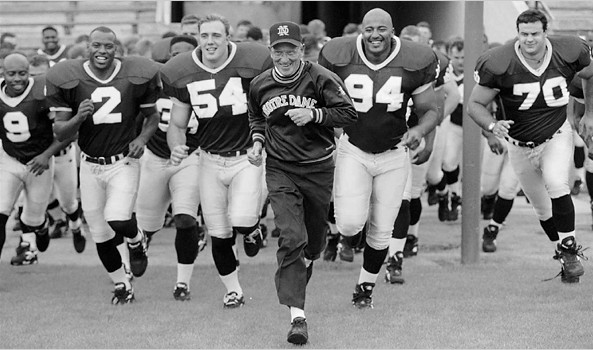Welcome to the first installment of a new Subway Domer off-season series called Irish Archives. In this series, I will breakdown plays from some of my favorite Notre Dame football games of the last 25 years. Let's begin by looking at Rodney Culver's touchdown against Miami in 1990.
Although the 1990 Notre Dame-Miami game is probably best remembered for Raghib Ismail's 94-yard kickoff return for a touchdown, Culver's touchdown was the play that sealed the game for the Irish. Clinging to a 22-20 lead late in the fourth quarter, Notre Dame faced a third-and-four from the Miami 21 yard line. Up to that point, the Irish had failed to score an offensive touchdown and instead settled for five field goals. Had Miami held the Irish to yet another field goal, Craig Erickson would have had an opportunity to engineer a game-winning touchdown drive. With the game hanging in the balance, Holtz called "300 fullback dump"—a play he had apparently drawn up at the team's pregame breakfast.
The Irish lined up in an Ace Slot formation with twin receivers to the field and tight end Derek Brown to the boundary. The Hurricanes showed blitz with six defenders at the line of scrimmage. If Miami man blitzed, Derek Brown's drag route would clear the Mike linebacker and either leave the middle open for Culver on the delayed angle route or leave him with a favorable match-up against a linebacker or safety. If Miami played zone, on the other hand, Culver would likely be open underneath the defenders dropping into intermediate zones.
Miami gambled with a Cover 0 blitz. Although Cover 0 blitzes are typically vulnerable over the middle, it appears that a blown assignment left Culver all alone on this play. Both the Mike linebacker and the strong safety followed Brown toward the field as Culver cut back to the boundary. Rick Mirer avoided the rush just long enough to complete the pass to Culver, who eventually dragged the safety into the end zone.
Lou Holtz's Bread and Butter
Holtz may have drawn up the play titled "300 fullback dump" the morning of the Miami game in 1990, but the "fullback dump" was already one of his go to passing concepts, particularly in the red zone. By fullback dump, I'm referring to the fullback running a delayed angle route after a tight end runs a drag route in the opposite direction. In fact, Holtz had used this very same concept two years earlier against the Hurricanes on Braxston Banks' touchdown.
As you can see, the only difference between this play and 300 fullback dump is the formation. Here, the Irish lined up in an I Formation with twin receivers to the field and tight end Derek Brown to the boundary. The Hurricanes were in a base 4-3 defense. Like 300 fullback dump, this play was designed to have the perimeter receivers run routes to stretch the defense vertically, while the tight end clears the middle for the fullback on the delayed angle route.
Miami didn't blitz on this play, but the result was the same. Mark Green occupied both the Sam linebacker and the strong safety with the wheel route, while both the Mike and the Will linebackers followed Brown on his drag route across the formation. Banks' delayed angle route left him wide open in the middle of the field.
One of the beauties of the fullback dump is that Holtz would run it from a variety of formations and personnel groupings. For example, Anthony Johnson scored Notre Dame's only offensive touchdown in the 1989 Michigan game on the fullback dump from a full-house formation.
The Irish faced third-and-goal from the six and lined up with two tight ends and three backs. Michigan stacked the box with nine defenders. Without any receivers split wide in the formation, the running backs each ran arrow routes to stretch the compacted defense, while the fullback and tight end worked the middle.
Michigan's linebackers look like they dropped into a zone coverage, allowing for Johnson to catch the ball underneath and turn up field for the score. Tony Rice's only completion the entire game was to Johnson on the fullback dump.
Conclusion
Rodney Culver's game-clinching touchdown against Miami was a well-designed play. While it makes for a nice story that Lou Holtz drew up the play over the breakfast table, the fullback dump concept was something Holtz had already been using for some time, especially in big games. Fortunately for the Irish, he continued using this concept with great success.


























